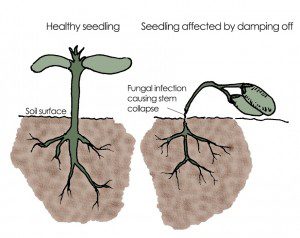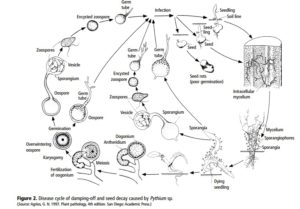Introduction:
Damping-off of seedlings, which is caused mostly by fungi, can be a complex of several diseases occurring separately or simultaneously. Most commonly, either Rhizoctonia or Pythium is involved. Botrytis, Sclerotinia, and Alternaria are also occasionally responsible for damping-off.
Symptoms:
Because damping-off is caused by several different
organisms on many different plants, symptoms of diseas e vary. Emerging or established seedlings fall over and die rapidly, collapsing even when soil moisture is adequate. When dug up and inspected, the plants are soft, dark colored and usually disintegrating. Seeds may fail to emerge at all.
e vary. Emerging or established seedlings fall over and die rapidly, collapsing even when soil moisture is adequate. When dug up and inspected, the plants are soft, dark colored and usually disintegrating. Seeds may fail to emerge at all.
Pre-emergence Infection: Seed decay before germination or rot of seedlings before emergence is commonly caused by a water mold, usually Pythium or sometimes Phytophthora.
Post-emergence Infection: Older seedlings may be infected at the soil surface and yet remain upright. Transplanted seedlings remain hard and stunted and eventually die. In some cases, water molds (such as Pythium) invade the rootlets at the tips and progress upward to the stem, whereupon the plant dies.
When infected with Pythium spp., the stems and roots of seedlings are black and rotted. Often the entire root system is soft and the outer root sloughs off.
Environmental conditions:
Damping-off occurs in both cool and warm soils since the organisms that cause disease are active at different soil temperatures. Disease occurs in moist to wet soils. The optimum temperatures for disease vary: Pythium aphanidermatum, the most common species of Pythium in the low desert, is most active in wet, warm soils, and is most problematic in summer months, while other Pythium species may be active in cooler soils in the winter. Rhizoctonia solani causes damping-off most frequently in cool, moist soils. Thielaviopsis basicola is most active at cooler temperatures in wet to moist soils.
Disease Cycle:
Damping-off is caused by several soilborne fungi or fungal-like organisms commonly found in soils that may or may not have been previously cultivated. None of these organisms needs a wound or natural opening to enter the plant, but wounding can increase the incidence of disease. When environmental conditions are right and a susceptible host is present, Pythium produces motile spores that can infect a plant root within a few minutes. These spores germinate to produce hyphae, microscopic tubular filaments that are the “body” of the organism. The hyphae grow into the roots, killing plant tissue as they grow. Pythium also produces sexual spores in the roots or in the soil that are resistant to adverse environmental conditions such as drying or cold temperatures. They can survive in a dormant state for months or years. These spores germinate and produce hyphae in the presence of a susceptible host when there is plenty of moisture. The hyphae penetrate the host root and begin the infection process.

Control:
Cultural Practices Host plant resistance to the pathogens that cause dampingoff is not available. Therefore, cultural practices are extremely important for prevention and control. Seed beds should be irrigated carefully to avoid excessive soil moisture. Plants and seeds should be planted when environmental conditions are best for the most rapid growth of seedlings. Use only healthy transplants. When buying young transplants, look for healthy white roots, sturdy stems and good color. Put seeds and transplants at the appropriate depth since deep planting slows emergence or growth and encourages disease.
In low desert areas, wait until temperatures cool down in October and November to transplant winter flowers to avoid Pythium and Rhizoctonia damping-off. In high desert areas, where annual flowers and vegetables are planted in the spring, wait until days are warm enough for good plant growth to avoid infections of Rhizoctonia and Thielaviopsis. Healthy, fast-growing seedlings and soils that dry slightly between irrigations are the best prevention methods for damping-off.
Chemical Control:
In infested soils, seed treatments may give some control. Look for treated seed from the distributor. Many seed companies offer the option of treated or non-treated seed. Seed is usually treated with metalaxyl for control of Pythium and with PCNB (pentachloronitrobenzene) or Chloroneb for control of Rhizoctonia. Seed treatments with myclobutanil are effective for control of Thielaviopsis basicola.